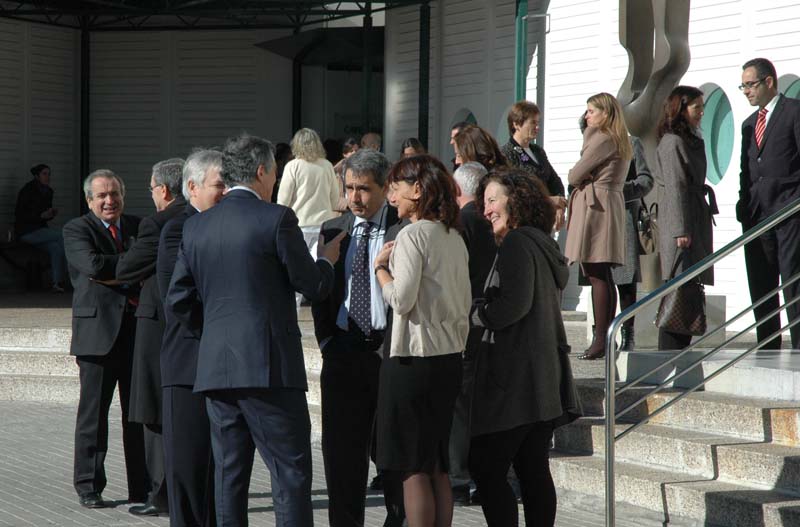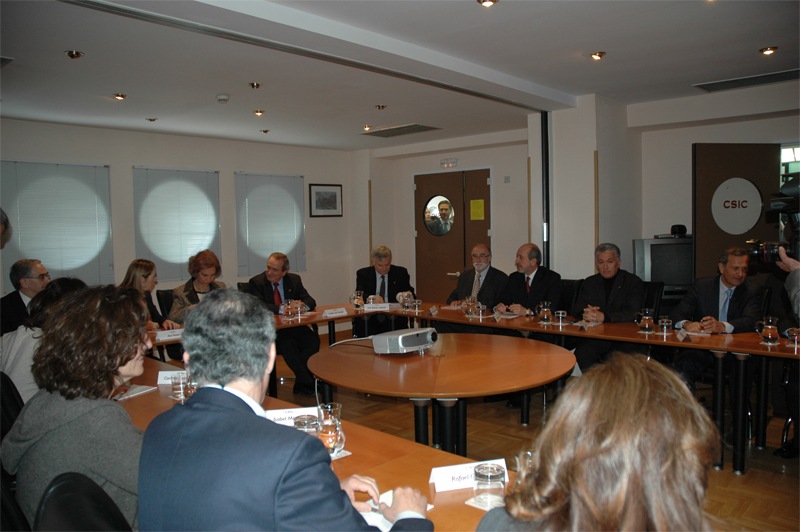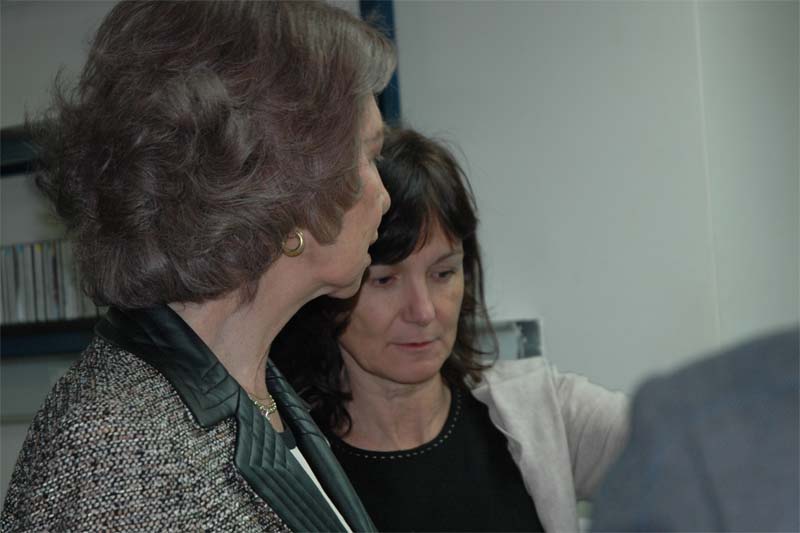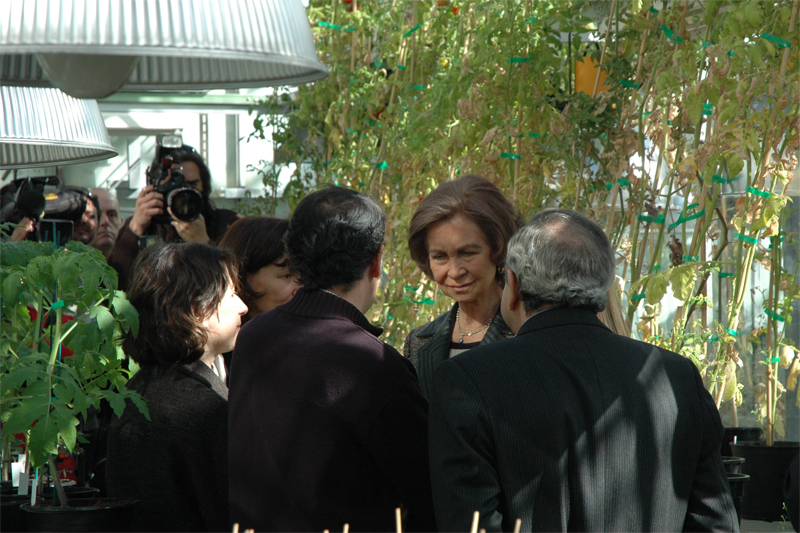Con motivo del vigésimo aniversario del Centro Nacional de Biotecnología del CSIC (CNB), la semana pasada, la Reina Doña Sofía visitó sus laboratorios en compañía de la directora del CNB, Carmen Castresana, y de su antecesor en el cargo, José María Valpuesta.
 Doña Sofía, acompañada, entre otras autoridades, por la ministra de Fomento, Ana Pastor, el presidente del CSIC, Emilio Lora-Tamayo, y el rector de la Universidad Autónoma de Madrid, José Mª Sanz Martínez, mantuvo una reunión de trabajo con el director saliente, José María Valpuesta; su sucesora, Carmen Castresana; tres investigadores que también ocuparon este puesto (Mariano Esteban, José Ramón Naranjo y José López Carrascosa); y el científico del CNB Carlos Martínez-Alonso, quien fuera en su momento presidente del CSIC y anterior Secretario de Estado de Investigación.
Doña Sofía, acompañada, entre otras autoridades, por la ministra de Fomento, Ana Pastor, el presidente del CSIC, Emilio Lora-Tamayo, y el rector de la Universidad Autónoma de Madrid, José Mª Sanz Martínez, mantuvo una reunión de trabajo con el director saliente, José María Valpuesta; su sucesora, Carmen Castresana; tres investigadores que también ocuparon este puesto (Mariano Esteban, José Ramón Naranjo y José López Carrascosa); y el científico del CNB Carlos Martínez-Alonso, quien fuera en su momento presidente del CSIC y anterior Secretario de Estado de Investigación.
Durante la reunión, Naranjo expuso los pormenores de su proyecto de investigación sobre el alzheimer que se financia, en parte, gracias a la Fundación Reina Sofía. Mariano Esteban tuvo ocasión asimismo de exponer a la Reina los avances obtenidos en los ensayos clínicos de su vacuna contra el sida y sus experimentos con vacunas contra la malaria, la leishmaniasis y la gripe. López Carrascosa, por su parte, explicó la marcha de sus trabajos sobre la estructura de los virus. Finalmente Martínez-Alonso habló de sus estudios sobre el papel de las células madre en el desarrollo y la metástasis del cáncer.
 A continuación realizaron un recorrido por las instalaciones del CNB, entre las que destacan el servicio de microscopía confocal, el microscopio electrónico, el citómetro de flujo, el laboratorio de pinzas ópticas y las instalaciones de cultivo de plantas del CNB.
A continuación realizaron un recorrido por las instalaciones del CNB, entre las que destacan el servicio de microscopía confocal, el microscopio electrónico, el citómetro de flujo, el laboratorio de pinzas ópticas y las instalaciones de cultivo de plantas del CNB.
La visita comenzó en el laboratorio de microscopía confocal. En el, Sylvia Gutiérrez Erlandsson mostró las imágenes digitales que se obtienen actualmente de las células gracias al empleo de láseres. Con esta tecnología y el uso de marcadores fluorescentes en las muestras, se pueden localizar los distintos componentes de las células.
Durante la visita al microscopio electrónico, Jaime Martín-Benito le pudo explicar cómo funcionan este tipo de microscopios y le estuvo enseñando algunos ejemplos como su último trabajo publicado en la revista Science en el que describen la estructura de las proteínas responsables de la replicación y expresión del material genético del virus de la gripe A.
 A continuación, María del Carmen Moreno-Ortiz explicó a Doña Sofía en qué consiste la técnica de la citometría de flujo. Entre los ejemplos interesantes de cómo se pueden analizar las distintas poblaciones celulares de una muestra, Moreno tuvo la oportunidad de mostrar cómo se pueden separar las células tumorales de las células normales.
A continuación, María del Carmen Moreno-Ortiz explicó a Doña Sofía en qué consiste la técnica de la citometría de flujo. Entre los ejemplos interesantes de cómo se pueden analizar las distintas poblaciones celulares de una muestra, Moreno tuvo la oportunidad de mostrar cómo se pueden separar las células tumorales de las células normales.
Su Majestad tuvo la oportunidad de conocer de mano de Elías Herrero y Borja Ibarra la llamada técnica de pinzas ópticas. Esta revolucionaria técnica permite a los investigadores atrapar cualquier molécula individualmente (desde una proteína al ADN) y medir los cambios que sufre mientras ejerce su función.
Finalmente, en el invernadero del CNB, Carlos Alonso y Salomé Prat tuvieron la oportunidad de mostrar brevemente las plantas que se cultivan y explicar las últimas investigaciones llevadas a cabo por los científicos del Departamento de Genética Molecular de Plantas.






